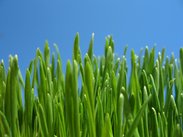© 2014 GOURMETWHEATGRASS.COM

ABOUT PLA CONTAINERS
The below statements are quotes compiled from various sources about "PLA" and the products that are made from it. The key words used to do a search for these sources of information are: "Food Toxicity PLA containers". No information was found that would indicate that "PLA" has any toxicity problems associated with food storage or growing edible plants in these containers. The sources of the information were not included because there are no adverse health issues associated with "PLA" and as far as Gourmet wheatgrass is concerned it is a non issue. The search terms used were done to satisfy anyone who had any doubts about the claims made by Gourmet Wheatgrass about the safety of the "PLA" growing containers. You are welcome to do your own research. A link for the last few quotes is included to demonstrate how extensively "PLA" has been researched. Click Here
PLA is the common name for Polylactic Acid or Polyactide. PLA is made from starch rich plants such as corn, wheat and sugar beets. These plants are first milled to separate the starch, from which is unrefined dextrose is processed. The unrefined dextrose goes through a fermentation process and the result is lactic cid PLA is both 100% biodegradable and 100% compostable. 100% compostable means that PLA products are fully renewable. It can be converted back to monomer and polymer, or, it can be biodegraded into water, carbon dioxide and organic materials. PLA is much more sustainable than regular petroleum made plastic. PLA is classified as GRAS (Generally Recognized as Safe) by the FDA. PLA products are not edible yet are generally non-toxic. Small pieces of PLA will most likely pass harmlessly through the gastrointestinal tract. Once passed through the gastrointestinal tract it will be eliminated in the stool.
The production of PLA produces fewer greenhouse gas emissions. when compared to conventional plastic production.
Biodegradable bowls are made from NatureWorks polylactic acid (PLA), which is derived from corn grown in the USA. These PLA bowls are fully biodegradable and compostable and meet the most stringent scientific requirements for biodegradability and compostability - and are ASTM D6400-99 certified for " compostable plastics".
PLA products are indistinguishable from normal plastic and as light and strong and fully degrade into water, carbon dioxide and organic material when composted. Food containers made from readily renewable resources are a conscientious alternative to the petroleum based plastic containers, which create toxicity and environmental pollution.
NatureWorks® exclusively uses corn starch as raw material for lactic acid production via lactic fermentation. Many studies have been conducted to find other sources of carbohydrates for lactic acid production. The use of a specific carbohydrate feedstock depends on its price, availability, and purity. Some agricultural by-products, which are potential substrates for lactic acid production include, cassava starch, lignocellulose/hemicellulose hydrolysates, cottonseed hulls, Jerusalem artichokes, corn cobs, corn stalks, beet molasses, wheat bran, rye flour, sweet sorghum, sugarcane press mud, cassava, barley starch, cellulose, carrot processing waste, molasses spent wash, corn fiber hydrolysates, and potato starch
According to its safety, biodegradability, and ability for being improved in a tailor-made fashion, the authors predict the substituting of many petrochemical-based polymers by PLA for almost all pharmaceutical and direct food contact packaging materials in the near future. PLA is a growing alternative as a “green” food packaging polymer. New applications have been claimed in the field of fresh products, where thermoformed PLA containers are used in retail markets for fruits, vegetables, and salads. The market capacity of these products packaged in PLA is unlimited.
Lactic acid is the lone monomer in the PLA structure and so, migrated agents are lactic acid monomers, dimmers, and oligomers. Conn and others (1995) investigated the safety of PLA as a food contact polymer under different conditions and studied the migration of most probable species from PLA. They concluded: (1) Very limited migration can be expected from PLA into foods that it contacts during the intended conditions of use. (2) The small amount of any material that might migrate from PLA into food will be lactic acid, or its dimers (lactoyl lactic acid and lactide) and oligomers that will be subsequently hydrolyzed in aqueous systems to lactic acid. Based on these findings, they concluded that PLA is safe and GRAS for its intended uses in fabricating articles intended for use in contact with food. The authors also mentioned that the projected intake of lactic acid from PLA is approximately 700 times less than the estimated daily lactic acid intake of a breast-fed infant.
PLA is the common name for Polylactic Acid or Polyactide. PLA is made from starch rich plants such as corn, wheat and sugar beets. These plants are first milled to separate the starch, from which is unrefined dextrose is processed. The unrefined dextrose goes through a fermentation process and the result is lactic cid PLA is both 100% biodegradable and 100% compostable. 100% compostable means that PLA products are fully renewable. It can be converted back to monomer and polymer, or, it can be biodegraded into water, carbon dioxide and organic materials. PLA is much more sustainable than regular petroleum made plastic. PLA is classified as GRAS (Generally Recognized as Safe) by the FDA. PLA products are not edible yet are generally non-toxic. Small pieces of PLA will most likely pass harmlessly through the gastrointestinal tract. Once passed through the gastrointestinal tract it will be eliminated in the stool.
The production of PLA produces fewer greenhouse gas emissions. when compared to conventional plastic production.
Biodegradable bowls are made from NatureWorks polylactic acid (PLA), which is derived from corn grown in the USA. These PLA bowls are fully biodegradable and compostable and meet the most stringent scientific requirements for biodegradability and compostability - and are ASTM D6400-99 certified for " compostable plastics".
PLA products are indistinguishable from normal plastic and as light and strong and fully degrade into water, carbon dioxide and organic material when composted. Food containers made from readily renewable resources are a conscientious alternative to the petroleum based plastic containers, which create toxicity and environmental pollution.
NatureWorks® exclusively uses corn starch as raw material for lactic acid production via lactic fermentation. Many studies have been conducted to find other sources of carbohydrates for lactic acid production. The use of a specific carbohydrate feedstock depends on its price, availability, and purity. Some agricultural by-products, which are potential substrates for lactic acid production include, cassava starch, lignocellulose/hemicellulose hydrolysates, cottonseed hulls, Jerusalem artichokes, corn cobs, corn stalks, beet molasses, wheat bran, rye flour, sweet sorghum, sugarcane press mud, cassava, barley starch, cellulose, carrot processing waste, molasses spent wash, corn fiber hydrolysates, and potato starch
According to its safety, biodegradability, and ability for being improved in a tailor-made fashion, the authors predict the substituting of many petrochemical-based polymers by PLA for almost all pharmaceutical and direct food contact packaging materials in the near future. PLA is a growing alternative as a “green” food packaging polymer. New applications have been claimed in the field of fresh products, where thermoformed PLA containers are used in retail markets for fruits, vegetables, and salads. The market capacity of these products packaged in PLA is unlimited.
Lactic acid is the lone monomer in the PLA structure and so, migrated agents are lactic acid monomers, dimmers, and oligomers. Conn and others (1995) investigated the safety of PLA as a food contact polymer under different conditions and studied the migration of most probable species from PLA. They concluded: (1) Very limited migration can be expected from PLA into foods that it contacts during the intended conditions of use. (2) The small amount of any material that might migrate from PLA into food will be lactic acid, or its dimers (lactoyl lactic acid and lactide) and oligomers that will be subsequently hydrolyzed in aqueous systems to lactic acid. Based on these findings, they concluded that PLA is safe and GRAS for its intended uses in fabricating articles intended for use in contact with food. The authors also mentioned that the projected intake of lactic acid from PLA is approximately 700 times less than the estimated daily lactic acid intake of a breast-fed infant.










For info & orders by phone call 845-641-6363 Open 7 days per week 10:00 - 4:00
Wheatgrass Live Plants & Ready to Grow Kits
Our plants are Pure, Enhanced, & Optimized
Our plants are Pure, Enhanced, & Optimized
Gourmet Wheatgrass